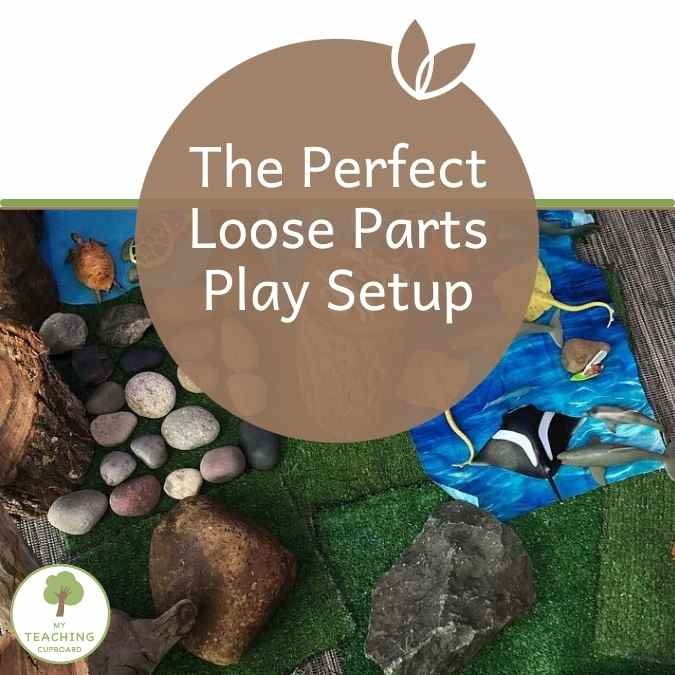
Provocations bring purpose to loose parts play, giving children a reason to experiment with the use of materials.
To effectively scaffold learning, teachers can observe and note each student’s interactions with the materials, helping to guide your future learning invitations.
These observations also provide insights for planning targeted skill-building activities that support social skills, cognitive development, and emotional development.
The process you can use to implement and observe provocations is:
-
Start with open-ended questions as children explore.
-
Take notes or photos of interactions to identify patterns in play.
-
Use observations to inform future provocations and extend learning.
Whether it is symbolic play, dramatic play, or the children are discovering the physical phenomenon of balance and movement, your role as observer is critical.
The job of the teacher is to observe the way in which students work with wood blocks, natural loose materials, or even old tires as well and pay attention to some signs of the gross motor development, hand-eye coordination, and cooperation.
So What Is Loose Parts Play?
Loose parts play: Loose parts play is a teaching technique that entails children interacting with moveable materials as opposed to the fixed toys and structured equipment. These materials may be natural or man-made and they must be open-ended to enable the children to manipulate, integrate, disengage, and innovate into infinity.
Examples of the Loose Part:
- Knock and porridge: buttons, spoons, corks, ribbons
- Classroom materials: blocks made of wood, beads, small boxes
The Loose Parts Play Matters Under the Early Childhood Education.
Playing with loose parts isn’t merely quietly occupying kids rules out the idea that simply keeping kids busy is learning it is research-supported as it aids in whole-child development. In early childhood classrooms, it promotes:
Innovation Creativity
The children are not restricted to instructions and definite results. They have the liberty of creating exclusive structures, patterns and accounts.
Problem-Solving Skills
Examples of loose parts would be anything that can promote critical thinking Children are explorers and study by trial and error experimenting with the results.
Social Emotional Development
Group work fosters group activity in terms of cooperation, sharing and negotiating skills, and enhances self-confidence.
Fine and Gross Motor Skills
- Manipulation of big and small objects enhances their hand-eye coordination and balance as well as their movement.
- Construction of an Ideal Loose Parts Play Space
- It is critical to create a cozy, orderly and engaging space. My Teaching Cupboard stresses a systematic yet versatile way of planning the set up of loose parts play areas. This is how you can make it yourself:
Select the Correct Place
- Put the arrangement in a corner and select one that is low in traffic and quiet.
- Make it with enough space to create free exploring, while not being crowded.
- Soft carpets or mats should be used to make the whole place look warm.
Think Before Making Materials
- Children like to have immediate access to cool content:
- Use glass containers so that they can be identified easily.
- Separate items by the size, texture or material.
- Label containers with printed words and pictures so that early literacy can be supported.
Turnover Materials on Addressing them on Regular Basis
To keep interest in loose parts fresh, change the range every three weeks or so.
For example:
- Week 1-2– wooden blocks, shells, beads
- Week 3-4: Pieces of bottles, t-shirts and corks
- Concerted substitute ensures that boredom is avoided and new creativity is facilitated.
Incorporate Nature
- Nature-based setups are extremely effective:
- Put out baskets of leaves, petals, stones and twigs.
- Make the use of natural textures to excite the sense of the kids.
- Promote outdoor loose parts play as often as possible
Hints on How to Bring About the Engagement in Loose Parts Play
1. Send out Invitations to Play
- Set up small themed scenarios that are interesting:
- a basket of seashells beside an image of the beach
- A book on quite how shapes were arranged in wood
- Fabrics and ribbons along with a mirror are used to express ourselves with
2. Model Exploration In the Absence of Directing
- Do not attempt to be telling instructions, be curious yourself:
- Won- Issue what becomes of these shells when we pile them up at length?
- How many beads can we squeeze in in the cup?
- This would enable learning to be child-initiated.
3. Encourage Storytelling
- The detachable accessories have an innate effect of encouraging tale-telling
- The questions should be open ended such as, “What do you think this button might be?”
- Use the materials to make characters, props and scenes.
4. Connect with Other Learning Areas
- Loose parts play is a wonderful interplay with:
- The development of math: beading, separating colors
Science: investigating textures and patterns and balance
Art: coming up with collages and statues
Literacy: objects can be used as tool to prop stories
Tips on Safety and Classroom Management
- There should be safety in addition to being enriching through loose parts play:
- Do not use sharp, toxic or extra tiny items that present choking dangers.
- Set good guidelines: nothing can go out the play zone and giving like it should be done.
- Be a supervisor but not an overseer provide freedom to explore but make intrusions when needed.
Want to learn more about your role in loose parts play? Check out this blog post: The Teacher’s Role in Loose Parts Play
